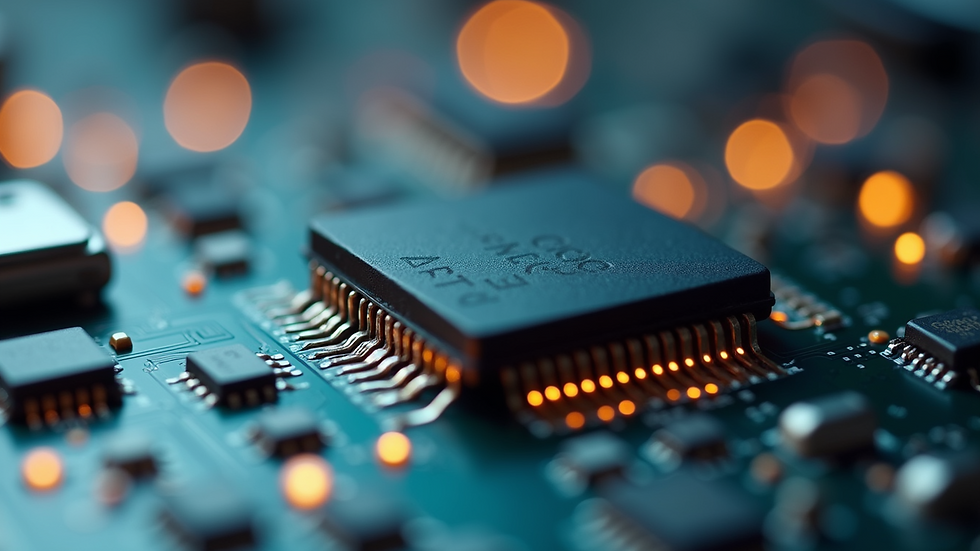Exclusive DI Technology for Microelectronics: Prevent Counterfeits
- Alexandre Outy
- Jul 11
- 3 min read
In today's fast-paced world, the demand for microelectronics is skyrocketing. From smartphones to medical devices, these tiny components play a crucial role in our daily lives. However, with this increased demand comes a significant risk: counterfeiting. Counterfeit microelectronics can lead to device failures, safety hazards, and financial losses. Fortunately, exclusive DI (Digital Identification) technology is emerging as a powerful tool to combat this issue.
In this blog post, we will explore how DI technology works, its benefits, and how it can help prevent counterfeits in the microelectronics industry.
Understanding Counterfeiting in Microelectronics
Counterfeiting in microelectronics is a growing concern. It involves the production of fake components that mimic genuine products. These counterfeit parts can be difficult to detect, making them a serious threat to manufacturers and consumers alike.
The Impact of Counterfeiting
The impact of counterfeit microelectronics is far-reaching. Here are some key points to consider:
Safety Risks: Counterfeit components may not meet safety standards, leading to potential hazards in devices.
Financial Losses: Companies can face significant financial losses due to recalls, legal issues, and damage to their reputation.
Supply Chain Disruption: Counterfeit parts can disrupt the supply chain, causing delays and increasing costs.
Why DI Technology is Essential
DI technology offers a solution to the counterfeiting problem. By providing a unique digital identity to each microelectronic component, manufacturers can ensure authenticity and traceability.
How DI Technology Works
DI technology uses advanced methods to create a digital fingerprint for each microelectronic component. This fingerprint is unique and can be verified at any point in the supply chain.
Key Features of DI Technology
Unique Identification: Each component receives a unique digital ID that cannot be replicated.
Traceability: The digital ID allows for easy tracking of components throughout the supply chain.
Verification: Manufacturers and consumers can verify the authenticity of components using the digital ID.
The Process of Implementation
Implementing DI technology involves several steps:
Integration: Manufacturers integrate DI technology into their production processes.
Registration: Each component is registered with a unique digital ID.
Verification: At various points in the supply chain, the digital ID can be verified to ensure authenticity.
Benefits of DI Technology
The benefits of DI technology are numerous. Here are some of the most significant advantages:
Enhanced Security
DI technology enhances security by making it nearly impossible for counterfeiters to replicate the digital ID. This added layer of security helps protect both manufacturers and consumers.
Improved Trust
With DI technology, manufacturers can build trust with their customers. Knowing that components are authentic gives consumers confidence in the products they purchase.
Cost Savings
By preventing counterfeiting, companies can save money on recalls, legal fees, and damage control. This can lead to significant cost savings in the long run.
Real-World Examples
Several companies are already using DI technology to combat counterfeiting in microelectronics. Here are a few notable examples:
Example 1: Semiconductor Manufacturer
A leading semiconductor manufacturer implemented DI technology to track their components from production to end-user. By using unique digital IDs, they were able to reduce counterfeit incidents by over 90%.
Example 2: Medical Device Company
A medical device company adopted DI technology to ensure the authenticity of their critical components. This not only improved safety but also enhanced their reputation in the market.
Challenges and Considerations
While DI technology offers many benefits, there are challenges to consider:
Initial Costs
The initial investment in DI technology can be significant. However, the long-term savings from preventing counterfeiting often outweigh these costs.
Industry Adoption
For DI technology to be effective, widespread adoption across the industry is necessary. This requires collaboration among manufacturers, suppliers, and regulatory bodies.
The Future of DI Technology in Microelectronics
The future of DI technology in microelectronics looks promising. As the demand for microelectronics continues to grow, so will the need for effective counterfeiting solutions.
Innovations on the Horizon
Innovations in DI technology are expected to enhance its effectiveness. For example, advancements in blockchain technology could further improve traceability and security.
Regulatory Support
As awareness of counterfeiting grows, regulatory bodies may implement stricter guidelines for the use of DI technology in microelectronics. This could drive further adoption and standardization.
Conclusion: A Safer Future for Microelectronics
In conclusion, exclusive DI technology is a game-changer in the fight against counterfeiting in microelectronics. By providing unique digital identities, this technology enhances security, builds trust, and offers significant cost savings.
As the industry continues to evolve, embracing DI technology will be essential for manufacturers looking to protect their products and consumers. The future of microelectronics is bright, and with the right tools, we can ensure a safer, more reliable market for everyone.



Comments